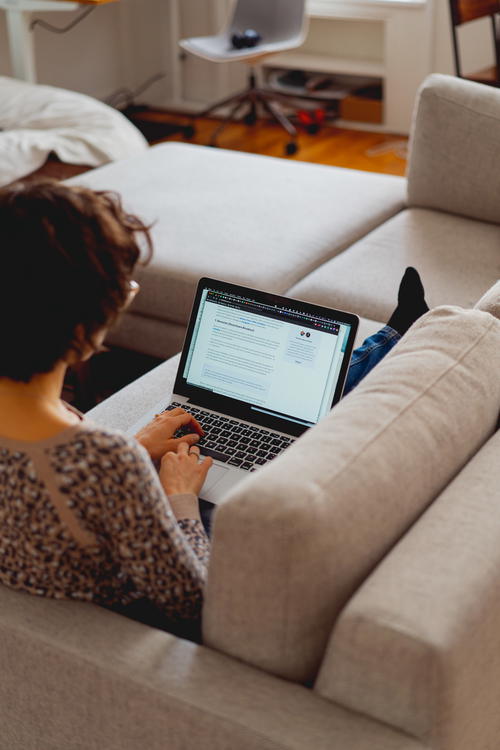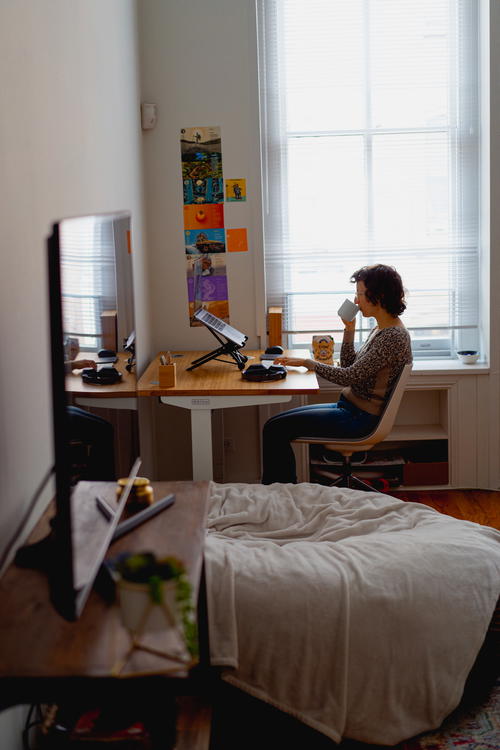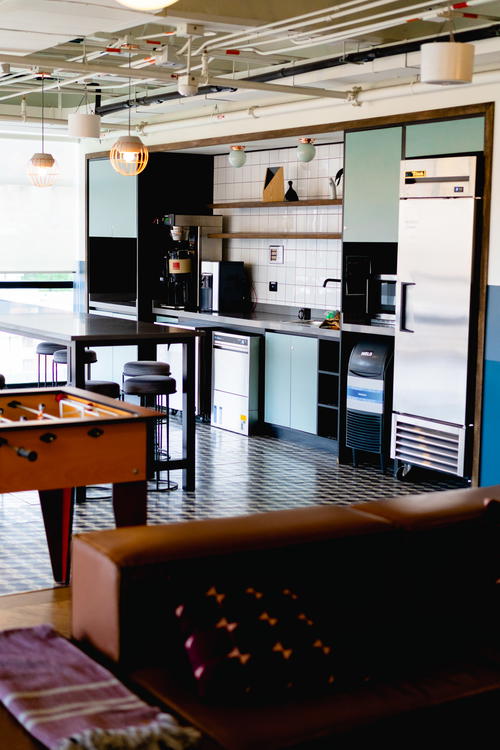How to Transition Back to an Office After Working From Home

Returning to the office after working from home? Here’s tips for how to transition back to office working,and how to go back to the office after working remotely.
This article may contain affiliate links. We earn a small commissions when you purchase via those links — and it's free for you. It's only us (Becca & Dan) working on this website, so we value your support! Read our privacy policy and learn more about us.
I’d like to give you a few tips for making the change to go back to an office after working remotely from home for a while.
It’s not easy, but can it be?
Once upon a time, there was the tight schedule everyone knew: set an alarm - snooze it a few times - get up - shower - figure out what to wear - leave home - commute - work for nine hours in an office - commute home - sleep - do it again.
Then came the new normal for those of us who transitioned in a snap to working from home.
The manner in which we all developed our daily work-from-home schedules reflected our ideals of working in pajamas, sleeping late and getting up just in time for a meeting, and slamming our laptops shut when evening came, only to soak into some Netflix on the couch.


A period of transition isn’t easy, and transitioning back into an office after working from home for even a short period of time can be stressful and all-consuming.
There’s the stress of what to wear. There’s the struggle to get back into your car to drive the hour to the office, or the schlep to get a monthly transit card again to take a train or bus every day for that 9-to-5.
Next, what about interacting with coworkers? Is there a way to crush your return to the office such that you get all your social skills back?
And, how will you stay in shape? Isn’t it great to work from home and do a yoga stretch midday? Or get out for a 3 pm run, back in time for a 4 pm meeting?
Oh, and what about food? Working from home is so nice, because you’ve got that fridge full of fruits and veggies (at least we do) and at work, it comes down to the items you have time to put into a bag.
There’s a lot to think about here. Let’s unpack the things to think about when going back to the office, whether it’s a full return to the office or a hybrid model of going in several days per week or month.
Let’s begin, shall we?
Figure out what to wear and what the dress code will be.
Offices come in all shapes and sizes of acceptable dress codes, but one thing’s for sure: dress for the job you want, not the job you have.
Okay, okay, this is really old and lame advice, but if you haven’t seen your colleagues in ages or if you’re meeting leadership for the first time, it can’t hurt to dress up to fair decency standards and snap out of that pajama funk you’ve been in while working from home.
Don’t get me wrong: I am the work-from-home-in-pajamas type. I find nothing comfier than wearing running shorts and a comfortable T-shirt and throwing on a scarf if I have a virtual meeting to attend by video.
But, when I head into an office, I find it important to put on ‘real’ pants, a ‘real’ shirt and ‘real’ shoes. Dan also helps me remember that you should dress your part when heading into the office, even if only a few of your coworkers are there for the day.
For larger companies, it pays to make a great first impression by dressing coolly to the nines (within acceptable dress code and level of formality) rather than looking sloppy or lazy. A lot of your appearance, whether in video or in person, contributes to how your colleagues consider your professionality.
So, what’s our lesson here? Find out if the office culture upon the return to the office is going to be super casual (think tech startup), business casual, dress-down Casual Fridays, or formal every day (law offices and finance). It’ll pay to have a wardrobe set up for success so that you don’t scramble for a blazer on day one.

Determine how to go about your commute, or new ways to jazz it up.
I can nearly guarantee that slashing the commute out of your day was one of your favorite parts of the benefits of working from home.
There’s a lot to get used to, especially schedule-wise, when weaving a commute back into your day and your week.
I’m also going to break it to you: eliminating the commute was one of the biggest ways I saved money while working remotely from home. I am sure you feel the same.
Working from home eliminated (for some people) buying gas, buying train tickets, buying parking spaces, paying for a metro card or bus pass, and maybe you even got rid of your car altogether.
Now it’s time to figure out how to commute, as you transition back to the office. Don’t worry, though, because maybe you can think outside the box and change it up.
For me, I used to commute every day via the NYC subway. I also lived in a few different apartments, and I’ve worked from a few different offices in Manhattan.
Nowadays, though, I’ve gotten back into biking. If I need to go somewhere, my first thought is: “Can I bike there?”
As you’ll see, if you choose to ‘jazz up your commute,’ there are some things to think about. For me, it’s that I have to remember to pack a different pair of shoes. I prefer to bike in my sneakers, but I don’t like to wear sneakers in an office setting.
For these reasons, it’s great to have a commuting backpack like the Aer Fit Pack for doubling as a gym bag, or the Troubadour Bivy Tote Backpack, which doubles as a classy tote that also fits in a bike basket!
See my battle with choosing shoes in this guide to choosing which shoes to travel with.
Figure out your commute, plan it, set aside a budget, and prepare yourself. I also recommend doing things that are productive during a commute, like downloading podcasts in advance, or getting some new books to enjoy.


Start off on a healthy note with lunches packed at home.
Maybe you’re with me in agreement that there are some long-term benefits of working from home, such as the health benefits of being near your fridge all day, or having the flexibility to work out during the time you used to spend commuting.
Well, it’s time to start off the return to the office with a health mindset. One way people save a lot of money working from home is because they tend to cook. When you’re out at the office, it’s all too easy to pick up a $15 salad or a $10 sandwich, multiple times per week and per month. It adds up!
My best advice is to plan your meals and snacks the night before, and maybe even leave your credit card at home when you venture back to the office. Bring what you wish to consume, and take control of your diet, tendencies and consumption.
This can be a big life change, but hopefully a nicely challenging one.

See if you can find ways to maintain fitness in your schedule during the return to the office.
While working from home, I would often use this guide of how to stay fit while working remotely. I like to take walks, or do yoga before my morning meeting, or go for a bike ride right after work before dinner, because I have the time.
With the commute back in the mix, you really have to put a focus on fitness if you want to maintain healthy habits for working out.
One way to do this is to find a gym near the office. Make sure it has a shower, and plan if you want to have a workout before, during, or after work, close to your work location.
You can also focus on starting a new schedule, shifting workout times to fit in before or after the time you need to spend commuting.
If your return to the office is a hybrid model, then accept that some days you may not have the time or energy to work out, but on other days, you can do a double workout.
Recall how to make small talk at the coffee maker and water cooler, and plan social events.
Are you out of practice with social skills? You’re probably not alone!
While working from home, we use lots of these tips for staying connected both to colleagues and family or friends.
When you’re back in the office during the transition, you can keep in touch with colleagues in person!
In this way, take advantage of the time you see colleagues. Plan a happy hour, plan an in-person book club meeting, or plan a competition.
Everyone is craving in-person contact, so your coworkers will thank you later.
Find out if you’ll have to bring your own laptop or if the company provides a setup.
One of the biggest perks of working from home was setting up a permanent home office, right?
Now that you’re transitioning back to working at the office, make sure you have your entire setup so that it’s ready for success.
This could be having an external monitor, or a double monitor plus laptop, or maybe you need a good pair of speakers or fancy headphones.
Find out if your company expects you to bring in a laptop from home, or if everything will be provided. Then, see the next tip below.
Our friend Ray Berry has an awesome tip to share, which is to bring touches of home to your desk at the office, like your favorite mugs, photos, flowers, lamps, or things that you like around you when working. Thanks, Ray!

Speak with leadership, your manager or the IT Dept. regarding desk equipment.
For desk equipment at your desk as your return to the office, you may be able to have some input.
For example, if you’re working from a laptop only at a hot desk, suggest a laptop stand setup with an external keyboard.
Do you need an ergonomic mouse? Or would a desk riser be a value-add to your setup?
Don’t be afraid to speak with management about investing in the desk setups for employees. If the company has the budget, it’s in their best interest to help everyone transition back to the office and work productively and collaboratively.

Research if your benefits have changed at all in regard to commuter benefits or flexible time.
Some companies are changing policies to reflect commuter benefits (or lack thereof) and/or flexible remote working days or time off. See if your company has instituted any changes, and how you can make the best of them during this time of transition.
Perhaps your company is offering credits for train passes, or tax deductions for transport on a monthly basis in a lump sum. These types of benefits certainly help employees with lowering annual taxes.
If your company has not announced any changes that better reflect the expected professional situation of the workforce, maybe it’s time to get some coworkers together and voice the need for change.


Talk out your options if you want a flexible return-to-the-office policy.
If your company is requiring that all employees come back to the 9-to-5 Monday through Friday on a regular basis, just like the Before Times, maybe it’s not a one-size-fits-all situation.
Find out if there are exceptions for parents, or anyone with a disability, or for anyone who has moved, who now has an excessive distance from the office.

Seek new ways to socialize with coworkers when you transition back to the office.
There are lots of ways to build relationships and companionship with colleagues. In fact, there’s a word for it: collegiality.
If your company is transitioning to a coworking space, then there’s actually room to be socializing and networking with other members of the shared workspace or coworking environment.
If your company is exploring new options for productive working environments, maybe someone needs to speak up about space at a coworking space. This helps companies save money by downsizing a bit, and there are lots of social benefits to coworking spaces. See more at our article where we answer the question, “What is a coworking space?”.
If a coworking space is out of the question and you’re returning right back to the same office you started at, see if there are new ways to socialize with coworkers in person.
Maybe a randomized Slack Donut program would work well for your company. Or, maybe you can suggest lunch-and-learns where employees gather in a conference room to socially learn about a topic. You could start a sports team, or a volunteering club. There are lots of ways to make the most of being back in real office life.

Think positively about the benefits of going back to work in the office again.
To me, some of the positive benefits of going back to the office are having a routine, and feeling like I “got outside and did something.” Some of us really need that!
There are other benefits, too. Maybe it’s as simple as the coffee machine. Maybe your office has free snacks (lucky you!). Or maybe there are beneficial opportunities for being in the office like fostering quicker collaboration with a colleague on your team, or a colleague in a different team from whom you can learn.


Focus on how to stay productive and what constitutes success for you.
I’d say that one of the biggest things to think about in the office is actually distraction. This is one of the reasons I like working from home, even though working remotely has its own distractions that affect productivity.
If you have chatty colleagues who keep you from focusing on writing emails, maybe you’re able to pick up and go work in the cafeteria, or in a quieter space like an empty conference or huddle room.
If to be productive you need music, then hopefully having your headphones on is something acceptable to do. I used to do this a LOT, and I’d listen to jazz or salsa (recommended!).
Find how you can stay productive once you transition back to the office, and stick with your gut.
Also, another tip from our friend Ray (a global expert!) is that you should never feel guilty for leaving your computer, while back in the office. Just like you’d do at home if you needed a break, then go take it: go make that drink, have a walk and walk away from the screen. Micromanaging is a thing of the past.

Assess how your spending might change from the costs of going back to the office.
Money. Who doesn’t love talking about money?
I mentioned above that there are a few hidden costs about going back to the office and transitioning back into a commute.
One topic of spending is the commute itself, and I mentioned previously that the cost of a car, bus, train, ferry or carpool may end in forking over some cash.
There are some more ‘free’ ways to commute, though. You can try biking, walking or running, as part of your commute. Don’t hesitate to ask coworkers about carpooling, or find a neighbor who heads into a downtown area at the same time. This can help cut costs when commuting.
Next is the cost of clothes for work. My suggestion here is to see if you can repurpose everyday essentials and dress them up to look like new outfits! You don’t necessarily have to start over with a fresh business casual wardrobe of all the season’s hottest trends if the funds are not presently in your bank account.
Lastly is the eating and maybe even the drinking. Gone are the days of the post-work Zoom happy hour where you could pour out half a cup of the bottle of wine you had lying around from last weekend. Going back to the office might mean happy hours, and work events.
Take the pressure off yourself to always say ‘yes,’ especially if the costs of a trip with coworkers or a night out with clients is going to cost you. Be transparent, and responsible. Most of all, take control so that you feel strong and confident.

Embrace the separation of work and home by honing in on work-life balance.
There’s a lot to be said about work-life balance when you’re working from home, but what about when you go back to the office?
Remember that the office is the place for work, and home is the place for no work (or, less work). Going back to the office can mean socially spending time at the office, but do keep in mind that a healthy split is ideal.
Everyone has a different ideal of the balance that works for them, so don’t be afraid to explore and experiment.


